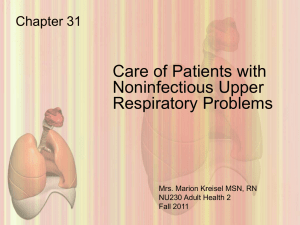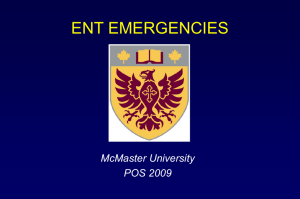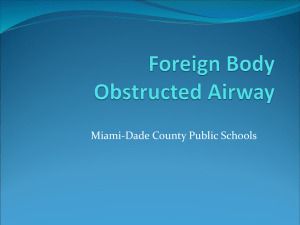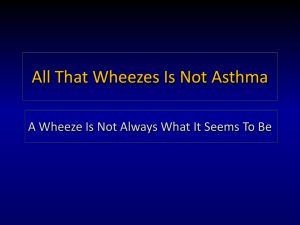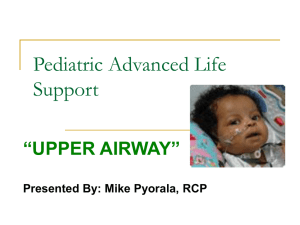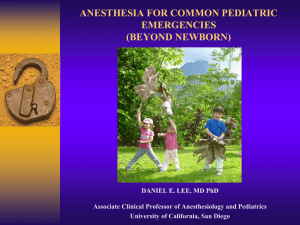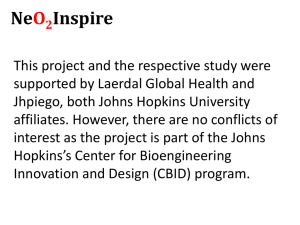ENT emergency - Damascus Hospital
advertisement
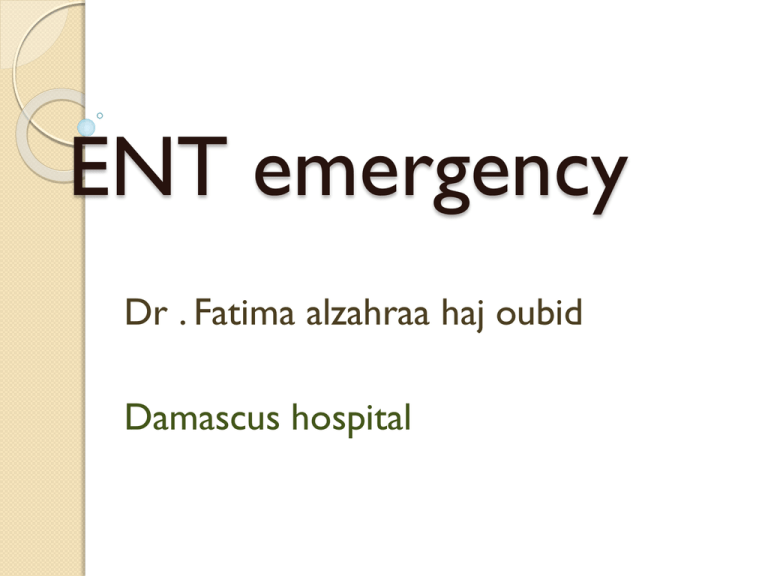
ENT emergency Dr . Fatima alzahraa haj oubid Damascus hospital Management of Emergent Airway Epistaxis AURICULAR HEMATOMA ENT FOREIGN BODIES TRAUMA FACIAL CERVICAL Causes of a Difficult Airway Trauma Foreign Body ( Midface , Mandible , Neck ) Bleeding into airway Caustic ingestion Thermal burns inflammation infection Deep Neck Space Abscess Ludwig’s angina Causes of a Difficult Airway Trismus Anaphylaxis Angioedema Previous head and neck surgery Vocal cord paralysis Macroglossia Anatomic/congenital factors LEMON Airway Assessment Look Evaluate Mallampati classification Obstruction Neck mobility Our Aim Maintain patent airway Secure airway Prevent aspiration Adequate and effective ventilation Further resuscitation Clear the Airway Clear the airway – oropharyngeal cavity of: Any secretions Any blood Vomitus Loose dentures Any foreign body obstructing the airway Open the Airway Jaw thrust Head tilt–chin lift Bag Mask Ventilation Key—ventilation volume: “enough to produce obvious chest rise” 1-Person difficult, less effective 2-Person easier, more effective Bag Mask Ventilation Sellick’s Maneuver Cricoid Pressure – to prevent regurgitation and aspiration Oropharyngeal Airway Nasopharyngeal Airway Endotracheal Intubation Endotracheal tube is passed into trachea of patient through oral or nasal route to ensure the patent airway and adequate ventilation Achieves all the goals of airway management Rapid, Simple, Safe and Non-surgical Maintains patent airway Protect lungs from aspiration Leak free ventilation Remains GOLD STANDARD of airway management Insertion Insertion Laryngeal Mask Airway Procedure Blunt Neck Trauma and Laryngotracheal Injury Strangulation Cervical Spine Injuries in BNT Vascular Injuries in BNT Penetrating neck injuries Zones of the Neck This actually applies to penetrating trauma but is useful to review when discussing neck anatomy. Zone I: thoracic inlet to cricoid cartilage Zone II: cricoid cartilage to the angle of mandible Zone III: angle of the mandible to skull base to Anatomy: Facial planes Hematomas, air tracks Bullet, metal tracks Carotid space: Carotid, IJV, CN X Retropharyngeal space: behind pharynx, anterior to prevertebral muscles Perivertebral space: muscles & soft tissue around vertebrae Bleeding that displaces prevertebral muscles anteriorly is associated with vertebral body fractures. Retropharyngeal carotid artery important for presurgical planning Esophageal injury can track air into RP, prevertebral space Missed esophageal injuries can present as retropharyngeal abscess, mediastinitis, sepsis www.medscape.com Morbidity: Vascular injury Major Signs Active bleeding Unstable/hypotension Expanding hematoma Pulsatile swelling Bruit, thrill Unilateral CNS deficit Pulse deficit Minor Signs Parasthesias Nonexpanding hematoma C spine or skull base fractures in MVAs Morbidity: Esophageal Injury Odynophagia, dysphagia, hematemesis Airway injury 25% have esophageal injury Transcervical trajectory Saliva in wound, subcutaneous emphysema Prevertebral air on lateral neck X ray Kietdumrongwong P & Hemachudha T 2005 Kietdumrongwong P & Hemachudha T. Pneumomediastinum as initial presentation of paralytic rabies: A case reportBMC Infectious Diseases 2005, 5:92. Morbidity: Airway Injury More common in blunt trauma 5-15% PNI will have laryngotracheal trauma Hoarseness, stridor, hemoptysis, difficulty breathing, pain Air leak in wound, difficult airway surgery!!! Majority airways managed by rapid sequence intubation (RSI) at scene or ED Mandavia DP 2000 Retrospective N = 748 11% emergent intubation -67% RSI with 100% success -33% fiberoptic 91% success -3 fiberoptic failures RSI Eggen JT 1993 N = 114 60% intubated, 22% ED No intubation complications Shearer VE 1993 N = 107 83% RSI with DL 100% success 6% surgical airway 100% 7% awake fiberoptic 98% 4% blind nasotracheal 75% •Eggen JT et al. Airway management, penetrating neck trauma. J Emerg Med 1993: 11: 31-5. •Mandavia DP et al. Emergency airway management in penetrating neck injury. Ann Emerg Med 2000; 35: 221-5. •Shearer VE et al. Airway management for patients with penetrating neck trauma: a retrospective study. Anasth Analg 1993; 77: 1135-8. •Mandavia et al •Shearer et al Morbidity: Airway Injury Baisakhiya N et al 2009 Baisakhiya N et al. Laryngotracheal Trauma . The Internet Journal of Otorhinolaryngology. 2009 Volume 9 Number 1 CT shows right thyroid cartilage fracture & air escape suggesting tracheal tear. Extensive subQ air. Patient managed with tracheostomy, reduction of fracture + fixation with 4-0 prolene. Tracheal partially excised with primary repair of trachea. Auricular Hematoma accumulation of blood in the subperichondrial space, secondary to blunt trauma . This creates a barrier for diffusion between the cartilage and the perichondrial vascularity, leading to necrosis of the cartilage . Auricular Hematoma Nasal trauma Nasal fracture is the most common of head and neck fractures . the amount of force required to create a fracture of the nasal structure is small, possibly as little as 25 pounds of pressure . Nasal trauma Evaluation : New deformity of the nose , often with epistaxis. Facial swelling and black eyes . X ray to exclude other bony facial fracture , And to document nasal fracture . Looking for septal hematoma . Nasal trauma Timing of repair : Within 1 - 3 hours of the time of injury before significant edema has developed . However, patients rarely present this early and often require reevaluation within 3 -7 days to allow for extensive facial edema to subside. Nasal trauma Anesthesia Local : for adults , cooperative patient . General : For children , uncoopetrative patient . Reduction Closed : safe , easy and reasonable cosmetic and functional results . Open :usually reserved for cases in which either a prior closed reduction has failed or malunion has occurred . epistaxis common problem , affects most of us at sometimes . It is usually mild and self-limiting . The anterior part ( little area ) of the nasal septum is the most frequent site for bleeding , because of rich blood supply . Anatomy Causes of epistaxis Local causes : Systemic causes : Nose picking . Trauma . Infection . Tumor . Idiopathic . Hypertension . Anti coagulant drug . NSAIDs . Coagulopathy ( haemophilia , leukaemia ). Hereditary haemorrhagic telangiectasia . treatment First aid : Lean forward . Pinch the fleshy part of the nose for 10 minutes . Put an icepack on the nasal bridge . Suck an ice cube . Assess blood loss . Take the pulse and blood presure . Gain intravenous access . treatment Anterior nasal packing posterior nasal packing Foreign Body Aspiration Aspiration in young children Lack of molar teeth Poorer mastication Tendency to put things in mouth Playing with things in mouth Immature protective laryngeal reflexes Symptoms and Physical findings Cough Dyspnea Wheezing Stridor Cyanosis Decreased breath sounds Tachypnea Rhonchi Somnolence ENT Foreign bodies Signs Foreign bodies in the ear : Pain . deafness . unilateral discharge . deafness . ENT Foreign bodies Signs Foreign bodies in the nose Unilateral foul smelling discharge . Unilateral nasal obstruction . Epistaxis . ENT Foreign bodies Signs Foreign bodies in the throat : Acute onset of symptoms Drooling Dysphagia tenderness in the neck . Pricking sensation on every swallow . management Insects may be drowned with olive oil . Pull foreign bodies by suction . Grasping with crocodile forceps . Refer to general anesethea if : Failed attempt . Uncooperative child . Suspected trauma to the drum . Pull foreign bodies by suction right-angled hook is passed beyond the object Peritonsillar Abscess ( quinsy ) bacterial infection can extend beyond the tonsillar capsule . The abscess lies in the space between the tonsillar capsule and the pharyngeal muscle . Peritonsillar Abscess ( quinsy ) Signs and symptoms : Sore tthroat . Pyrexia . Trismus . Drooling . Fetor . Peritonsillar swelling . Displacement of the uvula away from the affected side . Peritonsillar Abscess ( quinsy ) Peritonsillar Abscess ( quinsy ) Treatment : Admission of the patient . Re – hydration . Aspiration and send pus for culture . Incision . IV antibiotic . LUDWIGS ANGINA (16) LUDWIGS ANGINA (8) Epiglottitis Essentials of Diagnosis : Rapid progression of symptoms. Severe odynophagia with drooling . Irritability, fever, toxicity . Stridor Epiglottitis cellulitis involves multiple areas of the supraglottis . presents in children between the ages of 2 and 6 years . Haemophilus influenzae type B (HIB) is the responsible pathogen in most cases . http://1.bp.blogspot.com/_Fd2Fryp9wz0/TQg84FXXtSI/AAAAAAAABlE/h0gnkg2r09U/s1600/Acute_epiglottitis.jpg Epiglottitis lateral neck x-ray : "thumb print" sign . Epiglottitis flexible fiberoptic laryngoscopy : Redden and swollen epiglottic Epiglottitis Treatment : The airway is secured by endotracheal intubation or by tracheostomy . Parenteral antibiotic therapy (ceftriaxone or cefotaxime ) extubation is often possible after 48–72 hours . Laryngotracheobronchitis (Croup) Essentials of Diagnosis : Gradual onset of symptoms. Barking cough. Stridor Laryngotracheobronchitis (Croup) the most common infectious cause of airway obstruction in children . usually occurring between the ages of 6 months and 3 years . It is a viral infection most commonly caused by the parainfluenza virus . Laryngotracheobronchitis (Croup) Evaluation : x-rays of the neck and chest : subglottis may be narrowed . Laryngotracheobronchitis (Croup) Treatment : nebulized racemic epinephrine . nebulized and systemic steroids . Rarely endotracheal intubation . Sudden onset hearing loss Pathogenesis : Central nervous accident Autoimmune ( vasculitis ) . Trauma . Drugs ( amino glycosides ). Sudden onset hearing loss Evaluation : Full history and examination ESR and auto antibodies ( immune cause ) . MRI (CNS system ). Audiogram to confirm hearing loss . Sudden onset hearing loss Treatment : Admission for bed rest . Oral steroids . Acyclovir . Carbogen gas ( mixture of co2 and o2 5 min per hour ) Daily audiogram . Facial nerve palsy Upper motor neurone palsy : Usually as part of a stroke . Forehead spared . Look for other neurological signs . Facial nerve palsy Lower motor neurone palsy : The entire face is affected including forehead . Taste disturbance . Facial nerve palsy Causes of LMN facial palsy : Bell palsy . Ramsay hunt syndrome . Acute otitis media . Cholesteatoma . Acoustic neuroma . Trauma . Parotid gland malignancy . Bell palsy Probably viral in origin . You must exclude other causes of LMN palsy . Treatment : Prednisolone . Eye drops , lubricating gel to protect cornea from ulceration . Prognosis : Good 80% of patient fully recover . Bell palsy Thank you

